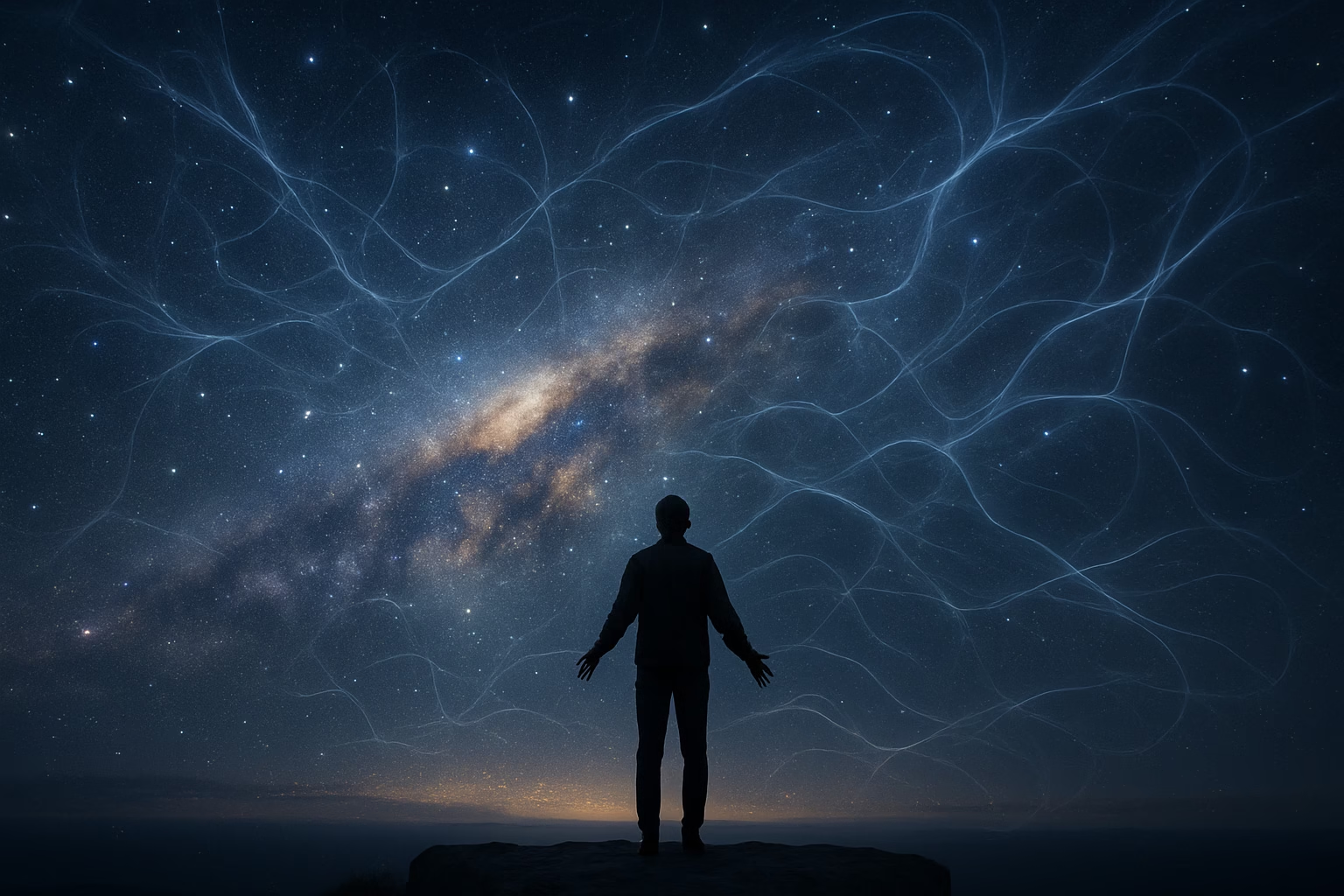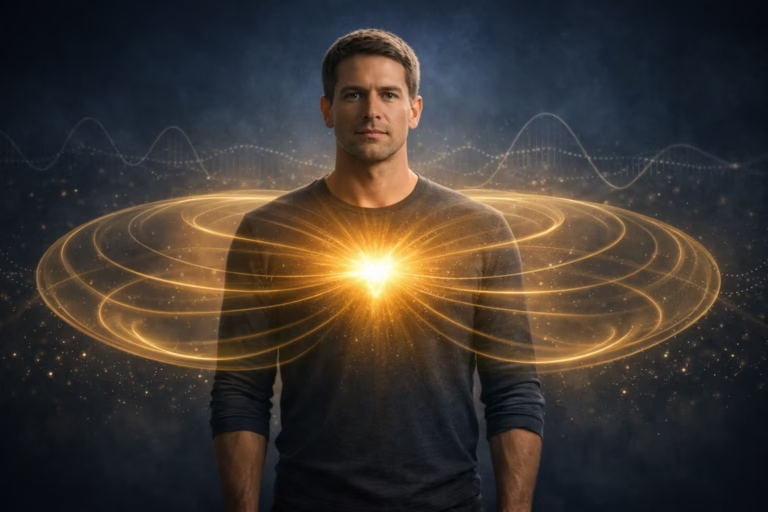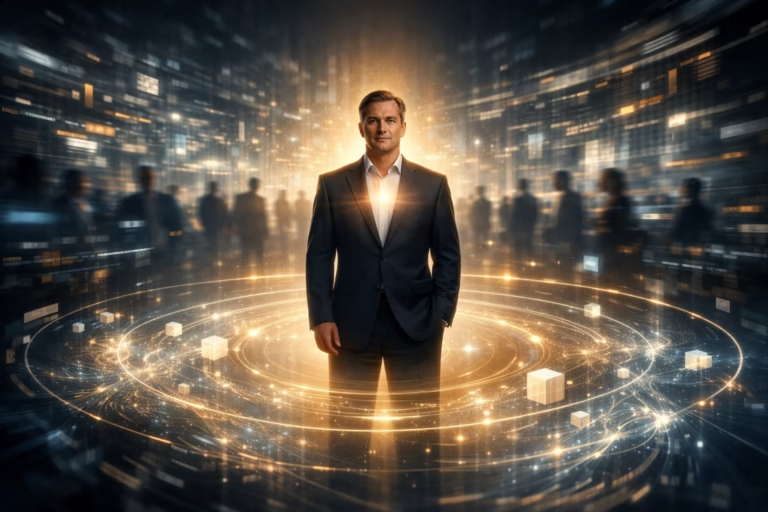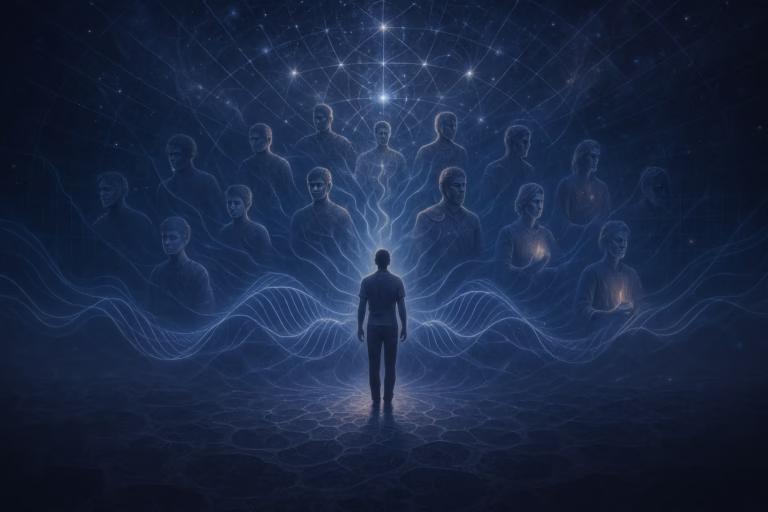PODCAST: Dark Matter and Divine Mind: Is the Universe Conscious?
Dark Matter and Divine Mind: Is the Universe Conscious?
On a clear, moonless night, the universe reveals itself as a breathtaking tapestry of light. We gaze upon a spectacle of stars, galaxies, and nebulae, and for millennia, this visible cosmos has been our canvas for understanding existence. Yet, modern cosmology has delivered a startling revelation: everything we can see, touch, and measure—every star, planet, and living thing—constitutes a mere 5% of the universe’s total contents. The remaining 95% is a profound, invisible mystery, a cosmic shadow realm composed of enigmatic dark matter and dark energy.1
This staggering imbalance forces a fundamental question: what if this pervasive “darkness” is not an empty absence, but the very substance of a cosmic mind? This report embarks on a journey to explore this radical possibility, blending the latest insights from cosmology with audacious theories of consciousness and the profound echoes of ancient wisdom. We will move from the known unknowns of modern physics to the deepest metaphysical questions, challenging the assumption of a cold, inert universe and inviting the possibility that we are part of a living, self-aware system.
The Shadow Side of Reality: A Cosmic Accounting
The story of dark matter and dark energy is a detective story on the grandest scale, one where scientists have found overwhelming evidence for something they cannot see. The first clue came from observing the rotational speed of galaxies. Early in the last century, astronomers discovered that the outer regions of spiral galaxies were rotating far too quickly to be held together by the gravitational pull of their visible stars and gas alone. Without an immense, unseen mass exerting an additional gravitational pull, these galaxies should have flown apart like a cosmic centrifuge spun out of control.1
The evidence for this invisible substance, which was named “dark matter,” has since grown stronger. A key piece of evidence is a phenomenon known as gravitational lensing. The immense gravitational pull of massive objects, including dark matter, bends the light traveling from distant galaxies to our telescopes. This bending causes the images of these galaxies to appear distorted, and by mapping these distortions, scientists can infer the location and presence of dark matter, even though it doesn’t absorb, reflect, or emit light itself.1 The evidence is so compelling that dark matter is now believed to outweigh visible matter by a factor of roughly six to one, making up about 27% of the universe.1
While dark matter acts as a cosmic scaffolding, clumping together to form the vast filaments of the “cosmic web” and allowing galaxies to form and grow, another equally mysterious force is at play.4 For billions of years after the Big Bang, the expansion of the universe was expected to slow down due to gravity. Yet, around five billion years ago, observations of distant supernovae revealed a shocking truth: the expansion of the universe began to speed up.1 This accelerated expansion is attributed to dark energy, a repulsive force that appears to be associated with the vacuum of space itself. Unlike dark matter, which clumps around galaxies, dark energy is thought to be uniformly distributed throughout the universe, its effect not diluted as space expands.3 Its impact is not local but global, driving the entire cosmos apart.3 This repulsive force is believed to make up the largest portion of the universe, an astonishing 68%.1
This cosmic accounting presents a profound and fascinating duality. Dark matter and dark energy are not merely unknowns; they represent opposing, fundamental forces that define the universe. One force, dark matter, is a binder—it pulls things together, creating structure, gravity, and the cosmic web. The other, dark energy, is a separator—it pushes things apart, accelerating dissolution and expansion. This suggests a universe in a state of dynamic tension, simultaneously building and unbuilding. This interplay of creation and destruction echoes the cyclical patterns of existence and non-existence found in many ancient spiritual cosmologies. The universe is not a static machine but a living system whose fundamental forces are in a constant, dramatic dance.
Furthermore, the very term “dark” offers a powerful metaphor. These phenomena are “dark” because they do not interact with light, making them invisible and inaccessible to direct observation.1 This mirrors the psychological concept of the subconscious mind. Our conscious minds, the part of ourselves we are aware of, are thought to be responsible for only a small fraction of our thoughts and actions. The vast majority, up to 90%, are believed to be driven by the invisible, inaccessible forces of our subconscious.6 This parallel suggests that the cosmic “darkness” of dark matter and dark energy may be an active, influencing force, much like the unconscious mind that operates within us. The report posits that what is “dark” to science may be what is “conscious” to philosophy, setting the stage for an inquiry into the nature of this unseen influence.
The Universe Within: Panpsychism, Idealism, and the Hard Problem
If the cosmos is predominantly composed of unseen, influencing forces, where does consciousness fit into this picture? The mystery of consciousness, particularly the “hard problem” articulated by philosopher David Chalmers, asks a fundamental question: why and how do physical processes give rise to a subjective inner life? This is the chasm that separates the objective, measurable world of physics from the subjective, felt experience of being.7
Panpsychism presents a radical solution to this problem. It is the view that mind, or a mind-like aspect, is a fundamental and ubiquitous feature of reality.7 Far from being a modern invention, this idea has roots in pre-Socratic Greek philosophy, with thinkers like Thales positing that “everything is full of gods,” and Plato arguing for a world soul.8 In its contemporary form, panpsychism proposes that consciousness is an intrinsic property of matter, as fundamental as mass or charge.7 This approach offers a way to “plug the hole” in the scientific narrative by suggesting that consciousness is not a mysterious byproduct of complex biological systems but is woven into the very fabric of existence.7
This view has given rise to provocative theories, such as the Orchestrated Objective Reduction (Orch-OR) theory, proposed by physicist Roger Penrose and anesthesiologist Stuart Hameroff. Orch-OR posits that consciousness is not a product of classical neural computation but arises from non-computable quantum processes within the brain’s microtubules, which are protein polymers inside neurons. The theory suggests that consciousness originates at the quantum level, where vibrations in these microtubules “orchestrate” a quantum process known as objective reduction, connecting the brain to experiences embedded in the fundamental geometry of spacetime.11 Penrose himself argues that consciousness cannot be accommodated within the framework of current physical theory and that a true understanding of the mind requires a new, appropriately extended science.13
The connection between consciousness and the physical world is further deepened by the “observer effect” in quantum mechanics, which demonstrates that the act of observation influences the behavior of subatomic particles.14 This scientific phenomenon resonates with the spiritual idea that our conscious intention can shape reality. The focus of our minds may not just be a passive process but a creative one, influencing the unfolding of the universe.14
Within this philosophical landscape, a crucial debate emerges between two competing models of consciousness. Panpsychism, in its most common form, can be seen as a “bottom-up” approach, where consciousness is a fragmented feature of reality.7 The subjective inner life we experience is believed to be an aggregation of these “bits” of consciousness from the microphysical level.9 This raises a significant challenge, often called the “combination problem”: how do these countless, isolated micro-experiences combine to form a single, unified macro-consciousness in a human brain?.16
Philosopher Bernardo Kastrup offers a compelling alternative with his Idealist philosophy, which is a “top-down” approach. Kastrup posits that consciousness is not a property of matter but is the fundamental, unitary reality itself, which he calls “Mind-at-Large”.9 In this view, individual minds are not an aggregation of smaller conscious parts, but rather a dissociation or localized expression of this single, undivided cosmic consciousness.9 For Kastrup, panpsychism is a seductive but dangerous intellectual “band-aid” for materialism, as it still places consciousness as subordinate to matter.9 This philosophical fork in the road is central to our inquiry: does the universe’s consciousness arise from the sum of its parts, or are the parts merely fragmented aspects of an original, unified cosmic mind? This distinction fundamentally changes our perceived relationship to the cosmos.
Another perspective is offered by thinkers like Deepak Chopra, who suggest that consciousness does not just observe reality but also “veils” it.17 According to this idea, our consciousness takes the underlying nonlocal, wave-like quantum reality and presents it to us as the local, classical, material world we perceive in our daily lives. This implies that our minds are not passive recipients of reality but active participants in its continuous construction.17 The very act of perceiving is an act of creation, making human consciousness a far more central and creative element in the cosmic story than previously thought.
The Cosmic Tapestry: Parallels from Physics and Metaphysics
The most profound parallels between science and spirituality emerge when we consider the concept of a unified cosmic fabric. Modern physics, particularly quantum field theory (QFT), has moved beyond the idea of a universe composed of discrete particles. Instead, it describes a reality made of continuous, space-filling fields.19 In this view, particles are not tiny billiard balls but are merely “excitations” or localized disturbances in these underlying fields. This framework provides a robust scientific basis for a single, interconnected, and unified reality.18
This resonates powerfully with the work of theoretical physicist David Bohm. In his book, Wholeness and the Implicate Order, Bohm proposed a cosmology where reality is divided into two orders.20 The “explicate order” is the visible, phenomenal world we experience, where things appear separate and distinct. The “implicate order,” however, is a deeper, undivided, and unified substrate from which our observable reality unfolds.20 Bohm described the relationship between these orders as being similar to a hologram, where the information for the whole is contained within each part. He referred to the dynamic process of reality unfolding from this unified whole as the “holomovement,” suggesting that a distinction between matter and consciousness may be impossible at this fundamental level.20
These modern scientific concepts find striking analogues in ancient wisdom traditions.
Vedanta and Brahman: The Vedantic school of Hindu philosophy speaks of Brahman, the universal consciousness that is the ultimate reality.21 Brahman is the one, indivisible essence that unifies all existence, transcending both individual and universal dimensions. The individual self, or Atman, is considered to be a part of this greater whole.21 This concept of a unified, fundamental reality from which all of existence arises bears a powerful resemblance to Bohm’s implicate order and the unified fields of QFT.
Taoism and The Tao: Similarly, Taoism centers on the concept of the Tao, the underlying, enigmatic process of transformation that gives rise to all of reality.23 The Tao is not a deity but the natural order of the universe, a continuous, unfolding movement. The goal of Taoist practice is to become “one” with the Tao, to eliminate the boundaries between the self and the totality of being.24 This metaphysical practice of merging with the universal flow is a direct parallel to the scientific idea of living as a part of a unified cosmic field or Bohm’s holomovement.
The fact that these ideas, one derived from centuries of empirical observation and the other from ancient meditative and philosophical traditions, converge on the same core principle of a unified reality suggests a deeper truth at play. The “problem of scale” is no longer a barrier but a bridge, revealing that the same underlying laws of interconnectedness may apply from the smallest quantum fluctuations to the largest cosmic structures, and perhaps even to the spiritual realm.
The following table summarizes some of these compelling conceptual bridges:
Modern Scientific Concept | Ancient Wisdom Tradition | Analogous Metaphysical Concept | Brief Description of the Parallel |
Holographic Principle (Bohm’s Implicate Order) | Vedanta | Brahman (Universal Consciousness) | Both propose an underlying, unified, and interconnected substrate of reality from which all phenomenal existence unfolds. |
Quantum Field Theory (QFT) | Taoism | The Tao | Both describe a fundamental, space-filling field or process from which all apparent particles and phenomena emerge as transient excitations. |
Cosmic Web (Dark Matter Scaffolding) | Gnosticism | The Demiurge (Flawed Creator God) | Both describe an unseen, non-luminous, structural reality that shapes and, metaphorically, imprisons the visible, material universe. |
The Divine Spark and the Cosmic Web: A Gnostic Re-reading of the Universe
While Vedanta and Taoism present a non-dualistic vision of a fundamentally unified cosmos, Gnostic thought offers a different and highly provocative perspective. This ancient tradition posits a radical duality between the spiritual and material realms.25 In Gnostic cosmology, a supreme, true God exists in a perfect spiritual realm, separate from the flawed material universe we inhabit. This visible universe, they believed, was the creation of an inferior, ignorant, or even malevolent entity known as the “Demiurge,” who trapped divine elements within the confines of matter.25
Central to this worldview is the concept of the “divine spark”—a fragment of the true God trapped within each human being.25 For the Gnostics, the human soul is this divine spark, and the ultimate goal of life is to achieve gnosis, or direct intuitive knowledge, to awaken this spark and facilitate its return to its divine source.25
A metaphorical re-reading of this ancient cosmology in the context of modern physics offers a startling narrative. The “cosmic web” formed by dark matter, which acts as the gravitational scaffolding for the entire universe 4, can be seen as a modern-day Demiurge. It is an unseen, dark, and indifferent physical structure upon which our visible, “normal” reality is built. Within this cold, structural system, human consciousness has emerged as a highly evolved, self-aware phenomenon. Our consciousness could be interpreted as a “divine spark” or a form of “intelligent information” that has come into being within this physical, material reality.25
This offers a unique and inspiring narrative of liberation. What if humanity’s role is not just to observe the cosmos but to “illuminate” its darkness? Our conscious inquiry, our scientific pursuit of knowledge, and our spiritual quest for understanding are not just about collecting data. They may be the modern manifestation of the Gnostic quest for gnosis, an act of freeing a trapped, conscious potential within the material realm. Our existence, in this sense, is an ongoing act of cosmic self-realization, transforming the universe from a “dark” physical structure into a conscious, self-knowing entity.
Our Role in the Living Cosmos: Finding Meaning Beyond the Absurd
Traditionally, many philosophies, such as existentialism, have contended that the universe is indifferent to our existence. This perspective, often called “the absurd,” highlights the conflict between our innate desire for meaning and a seemingly meaningless world.28 In this view, meaning is not inherent but must be self-created by each individual through their choices and actions.28
However, the hypothesis of a conscious universe fundamentally transforms this existential dilemma. If the universe is not an uncaring machine but a living, self-aware system, then the human being is no longer a meaningless “grain of sand” floating in an uncaring void.30 Instead, our existence takes on a profound, inherent purpose: to be the focal point through which the universe knows itself. As Roger Penrose once eloquently stated, “Consciousness is the phenomenon whereby the universe’s very existence is made known”.13
A recent theoretical framework for a conscious universe even offers a metaphorical model for this relationship. It proposes a “Cosmic Body” in which dark energy acts as a homogeneous substrate of pure awareness, and a “Cosmic Brain” where dark matter acts as the coordinating center of a “pure mental” state.27 Within this vast system, human consciousness is a highly evolved, localized expression, or “mental image,” of this larger cosmic intelligence.27 We are, quite literally, the universe observing and thinking about itself.
This perspective gives humanity a new and profound sense of responsibility. As suggested by the observer effect and related theories, our consciousness may not be a passive byproduct but a causal agent, actively shaping the reality we perceive.15 Our thoughts, our intentions, and our collective consciousness may not just be in the universe; they may be continuously participating in its unfolding. This elevates our role from passive spectators to active co-creators of cosmic reality, infusing our existence with a potent sense of purpose and power. We are not lost souls in a vast emptiness but vital, conscious organs of a living cosmos, whose thoughts and actions hold the power to shape the very story of existence.
A New Horizon for Mind and Cosmos
The journey from the perplexing mysteries of dark matter and dark energy to the profound question of a conscious universe is a testament to the insatiable human desire to understand our place in the cosmos. We have moved from a cold, inert universe to a dynamic system governed by opposing forces of creation and dissolution. We have explored audacious theories of consciousness that suggest mind is not an afterthought of biology but a fundamental feature of reality itself. And we have discovered striking conceptual bridges between modern science’s unified cosmic fabric and the ancient wisdom traditions of Vedanta, Taoism, and Gnosticism.
This is not a finished scientific theory but a new frontier of inquiry and imagination. It requires us to be intellectually honest, acknowledging where established evidence ends and where informed speculation begins. But it also invites us to push the boundaries of what we believe is possible. The most inspiring conclusion is not a final answer, but a new question. What if the visible, glowing body of the cosmos is merely the tip of a magnificent iceberg? What if the unseen darkness is the unconscious depth of a living, breathing mind?
This perspective asks us to re-evaluate our connection to the universe, not as separate entities but as vital, interconnected expressions of a single, cosmic consciousness. So, the next time you look up at the night sky, do not see just inert matter. See the glowing body of a living cosmos, and within it, recognize your own consciousness as the very phenomenon through which the universe’s profound and endless story is made known to itself.
Works cited
- Science 101: Dark Matter and Dark Energy | Argonne National …, accessed August 14, 2025, https://www.anl.gov/science-101/dark-matter-and-dark-energy
- Dark energy, explained – University of Chicago News, accessed August 14, 2025, https://news.uchicago.edu/explainer/dark-energy-explained
- Dark matter | CERN, accessed August 14, 2025, https://home.cern/science/physics/dark-matter
- How Does Dark Matter Affect the Evolution of the Universe? – Rubin Observatory, accessed August 14, 2025, https://rubinobservatory.org/explore/science-goals/dark-matter
- news.uchicago.edu, accessed August 14, 2025, https://news.uchicago.edu/explainer/dark-energy-explained#:~:text=Dark%20matter%20holds%20galaxies%20and,the%20universe%20to%20speed%20up.
- The Subconscious; the Dark Matter of our Psychology – influencePEOPLE, accessed August 14, 2025, https://influencepeople.biz/the-subconscious-the-dark-matter-of-our-psychology/
- Panpsychism and Consciousness | Beshara Magazine, accessed August 14, 2025, https://besharamagazine.org/science-technology/panpsychism-and-the-problem-of-consciousness/
- Panpsychism – Wikipedia, accessed August 14, 2025, https://en.wikipedia.org/wiki/Panpsychism
- The threat of panpsychism: a warning ~ Bernardo Kastrup, PhD, PhD, accessed August 14, 2025, https://www.bernardokastrup.com/2015/05/the-threat-of-panpsychism-warning.html
- The Riddle of a Conscious Universe | by Deepak Chopra | Medium, accessed August 14, 2025, https://deepakchopra.medium.com/the-riddle-of-a-conscious-universe-630598d15505
- Orchestrated objective reduction – Wikipedia, accessed August 14, 2025, https://en.wikipedia.org/wiki/Orchestrated_objective_reduction
- Is your brain really a computer, or is it a quantum orchestra tuned to the universe? – Interalia Magazine, accessed August 14, 2025, https://www.interaliamag.org/articles/stuart-hameroff-is-your-brain-really-a-computer-or-is-it-a-quantum-orchestra-tuned-to-the-universe/
- Roger Penrose – Quotes and Influence – Consciocentric, accessed August 14, 2025, https://www.consciocentric.com/Person/Roger-Penrose
- The Quantum Mind: Exploring Consciousness and Spirituality, accessed August 14, 2025, https://www.cslminneapolis.org/news/the-quantum-mind-exploring-consciousness-and-spirituality
- Quantum Physics and Spirituality: How Are They Connected?, accessed August 14, 2025, https://blog.mindvalley.com/quantum-physics-and-spirituality/
- Is the Universe Conscious? | Psychology Today, accessed August 14, 2025, https://www.psychologytoday.com/us/blog/consciousness-and-beyond/202409/is-the-universe-conscious
- Perceived Reality, Quantum Mechanics, and Consciousness – The Chopra Foundation, accessed August 14, 2025, https://www.choprafoundation.org/wp-content/uploads/2015/08/Cosmology-Time.pdf
- The Basic Tenets of Quantum Consciousness – YouTube, accessed August 14, 2025, https://www.youtube.com/watch?v=1P0ZRqJLRTI
- Quantum field theory – Wikipedia, accessed August 14, 2025, https://en.wikipedia.org/wiki/Quantum_field_theory
- Holographic consciousness – Wikipedia, accessed August 14, 2025, https://en.wikipedia.org/wiki/Holographic_consciousness
- Brahman as the universal: Significance and symbolism, accessed August 14, 2025, https://www.wisdomlib.org/concept/brahman-as-the-universal
- Brahman which is consciousness: Significance and symbolism, accessed August 14, 2025, https://www.wisdomlib.org/concept/brahman-which-is-consciousness
- Taoism – Wikipedia, accessed August 14, 2025, https://en.wikipedia.org/wiki/Taoism
- The Tao as a Path – Hanover College History Department, accessed August 14, 2025, https://history.hanover.edu/hhr/hhr4-3.html
- Gnosticism – Wikipedia, accessed August 14, 2025, https://en.wikipedia.org/wiki/Gnosticism
- Gnosticism: Modern Lessons in The Ancient Pursuit of Divine -, accessed August 14, 2025, https://gettherapybirmingham.com/gnosticism-the-ancient-pursuit-of-divine-knowledge/
- A unifying theory of physics and biological information through …, accessed August 14, 2025, https://pmc.ncbi.nlm.nih.gov/articles/PMC8205007/
- Finding meaning in life through existentialism – Counselling Directory, accessed August 14, 2025, https://www.counselling-directory.org.uk/articles/finding-meaning-in-life-through-existentialism
- Existential nihilism – Wikipedia, accessed August 14, 2025, https://en.wikipedia.org/wiki/Existential_nihilism
- Essay: Universal Consciousness – Literary Yard, accessed August 14, 2025, https://literaryyard.com/2014/03/29/essay-universal-consciousness/
- www.goodreads.com, accessed August 14, 2025, https://www.goodreads.com/author/quotes/1409.Roger_Penrose#:~:text=Consciousness%20is%20the%20phenomenon%20whereby%20the%20universe’s%20very%20existence%20is%20made%20known.&text=These%20are%20deep%20issues%2C%20and,seen%20to%20come%20into%20play.




